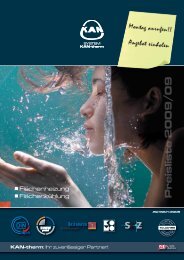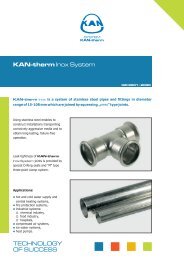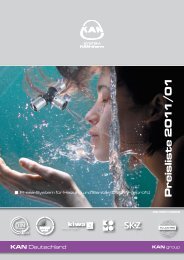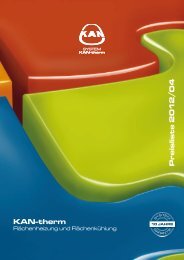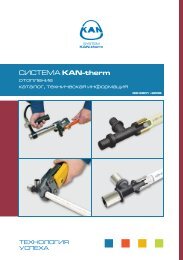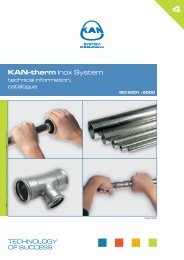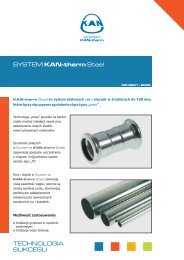KAN-therm Press System
KAN-therm Press System
KAN-therm Press System
You also want an ePaper? Increase the reach of your titles
YUMPU automatically turns print PDFs into web optimized ePapers that Google loves.
<strong>KAN</strong>-<strong>therm</strong> <strong>Press</strong> <strong>System</strong> - technical information<br />
<strong>KAN</strong>-<strong>therm</strong> <strong>Press</strong> <strong>System</strong> - press connections<br />
1 2 3<br />
Cut the pipe perpendicular to its axis<br />
using special cutter.<br />
Shape the pipe as required. Bend<br />
using external or internal spring. Obey<br />
minimum bending radius R b ≥ 5 D z .<br />
Calibrate the pipe and bevel its inner<br />
edge no deeper than to the aluminum<br />
layer.<br />
4 5 6<br />
Slide the steel sleeve over the pipe.<br />
Next, slide the pipe with the steel<br />
sleeve over the fitting up to the end of<br />
body. Control the O-Rings by<br />
watching the fitting when sliding the<br />
pipe with the steel sleeve. Slide the<br />
steel sleeve up to the fitting flange.<br />
Place the jaw on the steel sleeve so it<br />
touches the flange of fitting body. The<br />
external edge of the jaw should have a<br />
contact with the flange but not clasp<br />
the flange of fitting body.<br />
Start the press machine and make the<br />
connection.<br />
<strong>Press</strong> type fittings with pressed sleeve:<br />
• are self-sealing,<br />
• can be concealed in walls and also in floors, provided O-Rings have not been damaged during the assembly,<br />
• are made using a jaw adequate to a given pipe diameter,<br />
• have a diameter range of ∅16-63 mm,<br />
• should be made using tools delivered by <strong>KAN</strong>-<strong>therm</strong> (for diameters 16, 20, 32, 40 mm it is permissible to use "U"<br />
standard compatible jaws, for diameter ∅26 "C" standard compatible, and for ∅50, 63 mm "TH" standard compatible according<br />
to REMS catalog),<br />
• should be made at temperatures higher than 0°C.<br />
WARNING:<br />
In the pipe fitting design the "loose steel sleeve" technique has been applied - the steel sleeve is slid along with the pipe. In the final<br />
phase, such a design forces sliding the steel sleeve up to the body flange after the pipe has been stabilized in relation to the pipe<br />
fitting (assembly correctness control). The "loose steel sleeve" technique allows to maintain full control over O-Ring seals during<br />
assembly, and it enables to clean easily the fitting body in the case it gets dirty on a construction site.<br />
- 2 -



